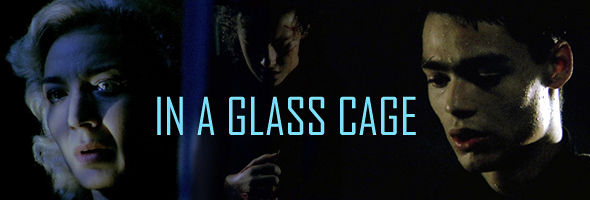
Color, 1986, 108m.
Directed by Agustí Villaronga
Starring GŁnter Meisner, David Sust, Marisa Paredes, Gisela Echevarria, Imma Colomier
Cult Epics (Blu-Ray & DVD) (US R0 HD/NTSC) / WS (1.85:1) (16:9)
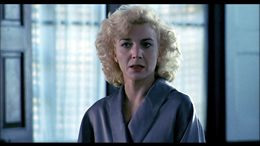 The increasing cinematic freedom in post-Franco Spain in the '80s produced nothing more shocking than this harrowing, deeply grueling, yet visually astonishing masterwork that sent audiences bolting for the exits back in the age of Top Gun. The film marked the assured, utterly fearless debut feature for one-time short film director Agusti Villaronga, who went on to helm the more genteel fantasy Moon Child and the haunting psychological horror film 99.9. However, nothing else in his filmography (or anyone else's) resembles this unflinching look into the human heart's darkest, nastiest corners.
The increasing cinematic freedom in post-Franco Spain in the '80s produced nothing more shocking than this harrowing, deeply grueling, yet visually astonishing masterwork that sent audiences bolting for the exits back in the age of Top Gun. The film marked the assured, utterly fearless debut feature for one-time short film director Agusti Villaronga, who went on to helm the more genteel fantasy Moon Child and the haunting psychological horror film 99.9. However, nothing else in his filmography (or anyone else's) resembles this unflinching look into the human heart's darkest, nastiest corners.
In a crumbling, abandoned building, former Nazi officer Klaus (The Boys from Brazil's Meisner) contemplates a trussed, heavily bruised young boy before whacking him with a board (mercifully offscreen). Meanwhile an unseen visitor gazes from outside the building and, after Klaus departs to hurl himself off a rooftop, steals the abuser's scrapbook of photos and scribblings. Flash forward a few months later; the suicidal Klaus is now confined to an iron lung as a result of his fall and tended to by his unhappy wife, Griselda (Pedro Almodovar regular Paredes), and their daughter Rena (Echevarria). One day their routine is disrupted by the sudden arrival of Angelo (Sust), a creepy young man who rushes into the house and locks himself in alone with Klaus, insisting he should be hired as the man's nurse. Despite Griselda's protests, Angelo is hired on despite his inability to even administer an injection. Even stranger, Angelo spends his private time alone with Klaus by depriving his charge of oxygen, reading entries from Klaus' diaries, and engaging in psychosexual routines; however, when Griselda accidentally trips over the plug to Klaus' iron lung, she awakens less than noble instincts within herself as well. The fragile household soon erupts in violence, and before long Angelo is bringing home victims of his own to dispatch for an audience 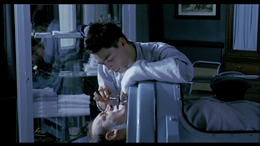 of one, the confined sadist with whom he shares a mysterious and terrifying bond from the past.
of one, the confined sadist with whom he shares a mysterious and terrifying bond from the past.
Initially shown in festivals by some misguided programmers as a gay interest title (with understandably disastrous results), this film was eventually discovered by adventurous horror connoisseurs who quickly placed it with Salo and Cannibal Holocaust in the pantheon of beautifully made cinematic atrocities. However, even among such barbed company, this Spanish production still packs a punch that leaves many viewers reeling long afterwards.
Anyone who can make it through the opening ten minutes will probably be able to stomach the following hour and a half, as it's obvious there won't be any punches pulled here involving either adults or children. However, though it contains more than its share of physical and psychological violence, In a Glass Cage is less overtly explicit than one might expect; blood is barely glimpsed, with the horror coming instead from the deeply committed performances which often verge on the unwatchable. A disclaimer thankfully explains that the child actors weren't harmed in any way during the film, which is a relief considering what the viewer is forced to watch; the needle injection bit ranks rather high on the list of scenes to never, ever play in mixed company. 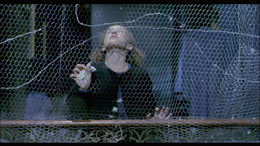
Villaronga also shows an unerring ability to jar the viewers' nerves while maintaining an aesthetic eye to rival Dario Argento's. Along with reflecting on global events, Villaronga subtly nods at film history as well; the eerie eyeball close-up which begins the film (with a clicking camera shutter to boot) echoes Michael Powell's Peeping Tom, while the lush, decaying villa and fluid camera movements recall such masters as Visconti and Ophuls. Two extended sequences in the middle of the film, Griselda's night walk to the basement and her subsequent confrontation with Angelo, are magnificent displays of horror filmmaking reminiscent of the finest Italian gialli. Not surprisingly, the sadistic narrative device of a psycho intentionally staging his murders as theatrical displays for his "captive audience" was later appropriated by Argento in a more baroque context for Opera, but this film never lets its audience forget about the real life violence which underpins the story; from the haunting Holocaust photographs under the opening credits to Angelo's concentration camp redecorating scheme, Villaronga constantly reminds us that the fallout from such intense horror is still lingering no matter how much we'd like to forget it.
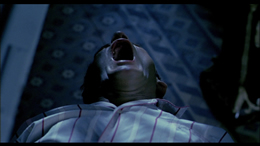 Since In a Glass Cage was barely exhibited in theaters, most viewers were first forced to watch it in a fuzzy, murky VHS transfer from Cinevista. Cult Epics' DVD offered a step up in several aspects, starting with the far more legible, optional English subtitles, but the non-anamorphic presentation revealed an uncomfortable amount of debris and compression flaws. Initial pressings also featured some dialogue out of synch for several scenes, but this was corrected for subsequent versions. A very strangely framed Villaronga appears for a lengthy video interview in which he discusses several aspects of the film, from handling the underage actors (whose scenes were treated as a series of innocent games later manipulated through editing into nightmare material) to the artistic inspirations for the striking, steely blue color scheme.
Since In a Glass Cage was barely exhibited in theaters, most viewers were first forced to watch it in a fuzzy, murky VHS transfer from Cinevista. Cult Epics' DVD offered a step up in several aspects, starting with the far more legible, optional English subtitles, but the non-anamorphic presentation revealed an uncomfortable amount of debris and compression flaws. Initial pressings also featured some dialogue out of synch for several scenes, but this was corrected for subsequent versions. A very strangely framed Villaronga appears for a lengthy video interview in which he discusses several aspects of the film, from handling the underage actors (whose scenes were treated as a series of innocent games later manipulated through editing into nightmare material) to the artistic inspirations for the striking, steely blue color scheme.
However, Cult Epics' 2011 Blu-Ray release (following an art house reissue in limited markets) doesn't just kill the old DVD transfer; it whacks it over the head a few more times for good measure and buries it six feet under the ground. Everything is improved drastically here, from the much deeper black levels (which become deliberately obscure and sometimes diffuse during night scenes as seen in theatrical prints) to the solid detail ranging from clothing textures to actors' hair. The whole film has a much stronger artistic impact here, and the subtitles are also presented in a slimmer, classier font for good measure. The DTS-HD MA 2.0 Stereo and 5.1 Surround audio (in synch!) also sounds crisper and much more detailed, doing justice to the superb score by Javier Navarette (who went on to an Oscar nomination for Pan's Labyrinth). It still sounds pretty much mono-based to these ears, but the bump in clarity is unmistakable. The previous Villaronga interview is ditched here in favor of a much better new one (in HD) in which he talks about the origins of the story, the color palette, the score, and all of his actors, including the film's importance as a comeback vehicle for Paredes before she embarked on the most celebrated period of her career. He also discusses his other filmmaking endeavors including several mentions (and clips) for his excellent, thematically similar 2010 film, Black Bread. Interestingly, one of the now-adult child "victims" from the film, Josue Guasch, appears for additional comments about working with Villaronga and his thoughts on the film today. Some of this material is also covered in an additional Q&A with Villaronga from 2010 at the Lincoln Film Center, with an interpreter taking audience questions and offering answers about the art direction and the touchy subject matter. Unlike the DVD, the Blu-Ray also includes the terrific original Spanish trailer (which was used almost verbatim for the Cinevista release in the US) in a new HD transfer as well. The package is rounded out with three early Villaronga shorts dating as far back as 1976: "Anta Mujer," "Laberint," and "Al Mayurca." All are sourced from the only remaining VHS copies in existence, and the content here is surprisingly abstract and even avant garde at times. Be prepared for girls in red dresses flying through the air, dancers in mud-like body stockings writing on a stage, and much, much more.
Reviewed on 10/25/11.



 The increasing cinematic freedom in post-Franco Spain in the '80s produced nothing more shocking than this harrowing, deeply grueling, yet visually astonishing masterwork that sent audiences bolting for the exits back in the age of Top Gun. The film marked the assured, utterly fearless debut feature for one-time short film director Agusti Villaronga, who went on to helm the more genteel fantasy Moon Child and the haunting psychological horror film 99.9. However, nothing else in his filmography (or anyone else's) resembles this unflinching look into the human heart's darkest, nastiest corners.
The increasing cinematic freedom in post-Franco Spain in the '80s produced nothing more shocking than this harrowing, deeply grueling, yet visually astonishing masterwork that sent audiences bolting for the exits back in the age of Top Gun. The film marked the assured, utterly fearless debut feature for one-time short film director Agusti Villaronga, who went on to helm the more genteel fantasy Moon Child and the haunting psychological horror film 99.9. However, nothing else in his filmography (or anyone else's) resembles this unflinching look into the human heart's darkest, nastiest corners. of one, the confined sadist with whom he shares a mysterious and terrifying bond from the past.
of one, the confined sadist with whom he shares a mysterious and terrifying bond from the past. 
 Since In a Glass Cage was barely exhibited in theaters, most viewers were first forced to watch it in a fuzzy, murky VHS transfer from Cinevista. Cult Epics' DVD offered a step up in several aspects, starting with the far more legible, optional English subtitles, but the non-anamorphic presentation revealed an uncomfortable amount of debris and compression flaws. Initial pressings also featured some dialogue out of synch for several scenes, but this was corrected for subsequent versions. A very strangely framed Villaronga appears for a lengthy video interview in which he discusses several aspects of the film, from handling the underage actors (whose scenes were treated as a series of innocent games later manipulated through editing into nightmare material) to the artistic inspirations for the striking, steely blue color scheme.
Since In a Glass Cage was barely exhibited in theaters, most viewers were first forced to watch it in a fuzzy, murky VHS transfer from Cinevista. Cult Epics' DVD offered a step up in several aspects, starting with the far more legible, optional English subtitles, but the non-anamorphic presentation revealed an uncomfortable amount of debris and compression flaws. Initial pressings also featured some dialogue out of synch for several scenes, but this was corrected for subsequent versions. A very strangely framed Villaronga appears for a lengthy video interview in which he discusses several aspects of the film, from handling the underage actors (whose scenes were treated as a series of innocent games later manipulated through editing into nightmare material) to the artistic inspirations for the striking, steely blue color scheme.
![]()